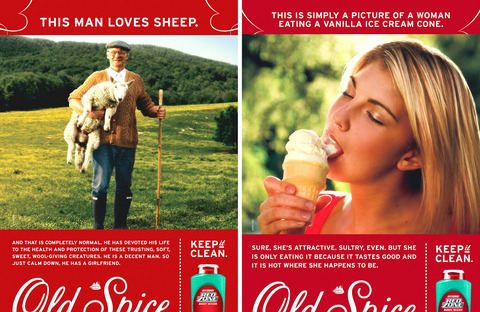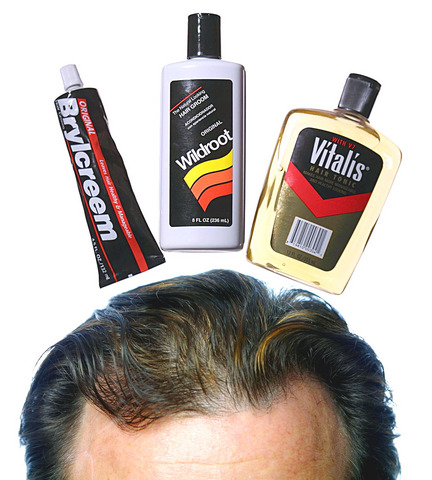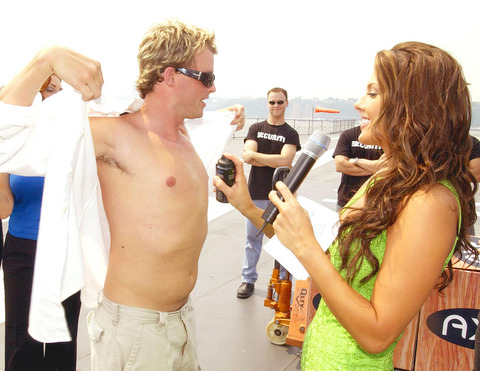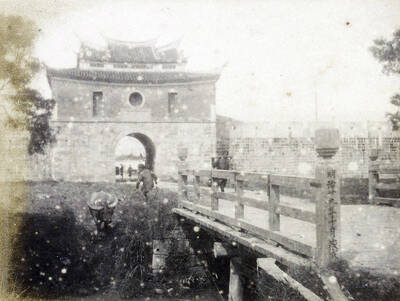Can an agency known for offbeat campaigns that appeal to younger men, for brands like Nike, ESPN and Miller High Life, freshen the stodgy image of the Old Spice line of men's grooming products?
That is the estimated US$100 million question being asked as the agency, Wieden & Kennedy, introduces this week its first work for Old Spice since landing the creative and media accounts for the brand in February 2006.
A television, print and online campaign with the theme "Experience is everything" will take a cheeky look at modern masculinity as it seeks to extol the virtues of Old Spice as a brand family as well as to stimulate sales of specific products like deodorants, body washes and fragrances.

PHOTOS: NY TIMES NEWS SERVICE
For example, a Web site (experienceoldspice.com) will provide advice on topics like "Animals you can ride and how to ride them," "Easy ways to avoid getting picked in a lineup" and "How to talk your way across an African border sans passport."
Print ads will offer wry captions for photographs of subjects like a shepherd ("This man loves sheep"), a woman eating an ice cream cone and a foot-long frankfurter. And commercials will feature a puckish spokesman, the actor Bruce Campbell of the droll Evil Dead movies, sending up the concept of taking advice from your elders.
The maker of Old Spice, Procter & Gamble, surprised Madison Avenue last year by shifting the assignments for the brand, with spending estimated at US$100 million a year, to Wieden & Kennedy from two much larger Procter mainstay agencies, Saatchi & Saatchi and the Starcom MediaVest Group, both part of the Publicis Groupe.

Wieden & Kennedy is best known for its assertive ads for Nike ("Just do it"), a series of wacky spots for the SportsCenter show on ESPN and the dryly humorous High Life Man campaign for Miller High Life beer. The Old Spice account includes sibling products sold under names like High Endurance and Red Zone along with the familiar cologne and after-shave in the buoy-shaped bottles, which date to 1938.
Procter has long been famous for earnest, product-oriented campaigns concentrating on the efficacy of its detergents, soaps and shampoos and replete with demonstrations pitting "Brand X" against Procter counterparts. Such straightforward, prosaic approaches have lost favor, however, with the younger consumers that advertisers most covet.
Proof of that is the startlingly rapid growth of the Axe line of men's grooming products sold by a principal Procter rival, Unilever, which now vie for category leadership with Old Spice in sales at drug stores and discount chains in the US. (Old Spice sales have grown, too, but Axe's have grown at a faster pace.)

Axe ads, created by Bartle Bogle Hegarty, take a zany, off-kilter approach as embodied by slogans like "How dirty boys get clean." Axe campaigns celebrate the sex appeal with which Axe promises to imbue its users rather than how effective the brand is in killing the germs that cause perspiration odor.
As a result, Procter began to rethink its creative approach for brands like Old Spice. After many exploratory meetings with Wieden & Kennedy and similar agencies — iconoclastic independents with reputations for rule-breaking ads — Procter finally gave Wieden & Kennedy some work, first the Eukanuba pet-food assignment in 2005 and then Old Spice.
"This is part of a significant brand-building experiment at P&G," said Carl Stealey, Old Spice brand manager at Procter in Cincinnati.
"We are a product-based company," he added. "As the men's grooming category explodes and new entrants come in, we've had to evolve and refine our positioning."
"Wieden has tremendous capability and expertise in reaching the young target, talking with them as opposed to at them," Stealey said, referring to campaigns for ESPN and Nike that are aimed at the same audience as Old Spice, generally males ages 12 to 34.
Research aimed at the target consumer found something unexpected: the Old Spice brand's legacy was a benefit rather than a burden. The reason was that younger consumers tend to seek out venerable products they perceive as cool because they are authentic; examples include Converse sneakers and Lee jeans.
"Previous generations loved Old Spice and had a more emotional attachment to it," said Monica Taylor, an art director at Wieden & Kennedy who is one of two creative directors on the account. "I remember my dad using it; it was such a deep, rich brand."
Mark Fitzloff, a copywriter at Wieden & Kennedy who is the other creative director on the account, chimed in: "If you put Nikes on your feet, you're making a statement. If you're using Old Spice, you're not. Procter wanted to see if they could change that."
"Our timing was good because this is a moment when everyone appreciates authenticity, when retro is not necessarily a bad word," Fitzloff said. "So we can say, 'You can either be authentic or trendy."'
That also helps Old Spice, which has been around for decades, to sharpen its differentiation from Axe, which Unilever introduced in the US only four years ago.
"They have a clean slate," Taylor said of the Axe products, which also include fragrances, deodorants and body washes, "but they have had to invent a personality."
To underscore authenticity for Old Spice, the campaign gives a prominent role to the brand's original trappings and trade dress, including the cursive script logo, the clipper ship from the fragrance bottles and the vintage whistled commercial jingle. But they are treated playfully rather than reverentially, in a manner Taylor described as an "inside-the-joke feeling."
For example, a print ad for Old Spice fragrance, featuring a 1968 photograph of the actress Faye Dunaway sprawled out before a roaring fire, declares, "If your grandfather hadn't worn it, you wouldn't exist."
And the commercials with Campbell make a visual jest by showing him passing a painting of the clipper ship as he walks across a room. The joke comes when viewers realize the painting runs the length of the room and the ship has scores of sails and masts.
"The tone does have, I would say, a self-awareness," Stealey said, "a sort of wink about it that by and large is lacking in the category."
"We're looking forward to the results," he added.
The theme of "Experience is everything" is meant to convey "that with our heritage and history, Old Spice is uniquely positioned to get you that experience," Stealey said, adding: "For years, we've been counseled to drop the 'Old' from 'Old Spice.' I'm here to say we will not do that."
Too bad that it is probably too late for General Motors to bring back Oldsmobile.

June 9 to June 15 A photo of two men riding trendy high-wheel Penny-Farthing bicycles past a Qing Dynasty gate aptly captures the essence of Taipei in 1897 — a newly colonized city on the cusp of great change. The Japanese began making significant modifications to the cityscape in 1899, tearing down Qing-era structures, widening boulevards and installing Western-style infrastructure and buildings. The photographer, Minosuke Imamura, only spent a year in Taiwan as a cartographer for the governor-general’s office, but he left behind a treasure trove of 130 images showing life at the onset of Japanese rule, spanning July 1897 to

One of the most important gripes that Taiwanese have about the Democratic Progressive Party (DPP) is that it has failed to deliver concretely on higher wages, housing prices and other bread-and-butter issues. The parallel complaint is that the DPP cares only about glamor issues, such as removing markers of Chinese Nationalist Party (KMT) colonialism by renaming them, or what the KMT codes as “de-Sinification.” Once again, as a critical election looms, the DPP is presenting evidence for that charge. The KMT was quick to jump on the recent proposal of the Ministry of the Interior (MOI) to rename roads that symbolize

On the evening of June 1, Control Yuan Secretary-General Lee Chun-yi (李俊俋) apologized and resigned in disgrace. His crime was instructing his driver to use a Control Yuan vehicle to transport his dog to a pet grooming salon. The Control Yuan is the government branch that investigates, audits and impeaches government officials for, among other things, misuse of government funds, so his misuse of a government vehicle was highly inappropriate. If this story were told to anyone living in the golden era of swaggering gangsters, flashy nouveau riche businessmen, and corrupt “black gold” politics of the 1980s and 1990s, they would have laughed.

It was just before 6am on a sunny November morning and I could hardly contain my excitement as I arrived at the wharf where I would catch the boat to one of Penghu’s most difficult-to-access islands, a trip that had been on my list for nearly a decade. Little did I know, my dream would soon be crushed. Unsure about which boat was heading to Huayu (花嶼), I found someone who appeared to be a local and asked if this was the right place to wait. “Oh, the boat to Huayu’s been canceled today,” she told me. I couldn’t believe my ears. Surely,